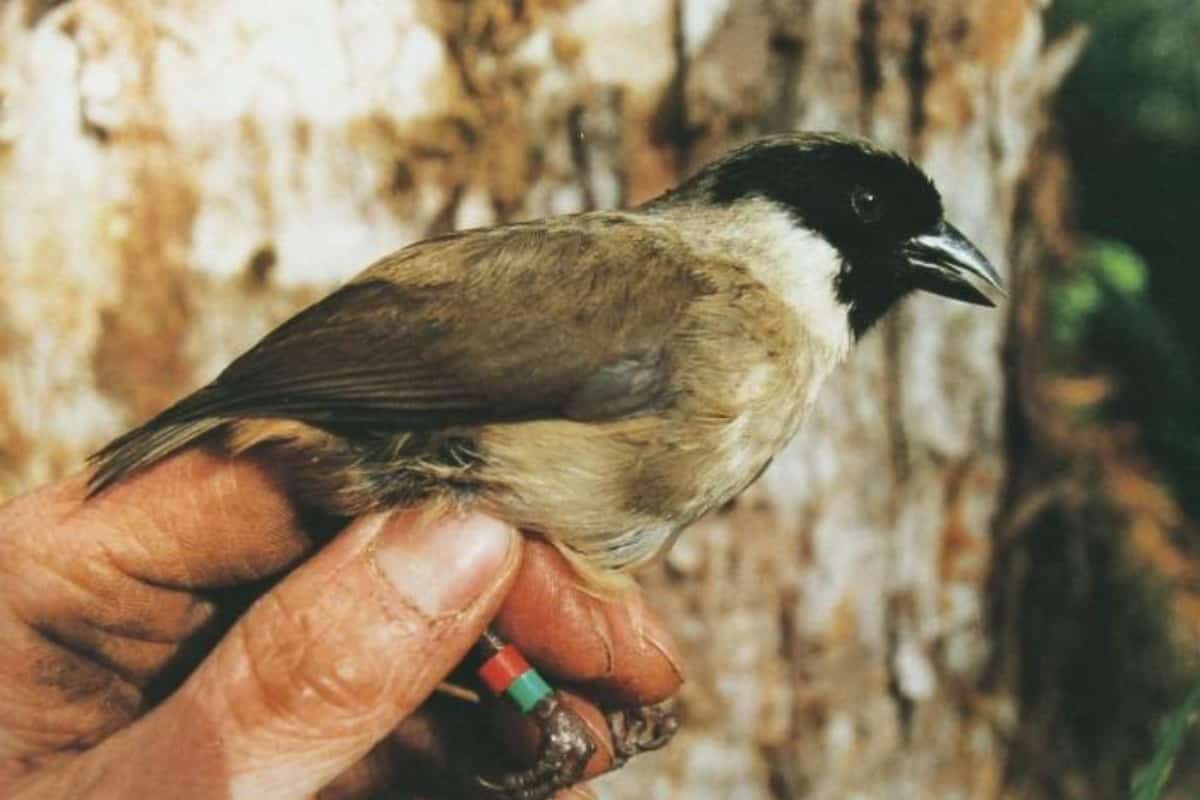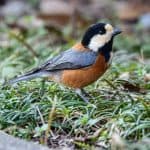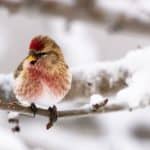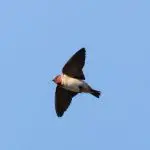Common Name: Poʻouli
Scientific Name: (Melamprosops phaeosom)| Size | Diet | Range in Hawaii | Status in Hawaii |
|---|---|---|---|
| 6 in. - 7 in. | nectar and insects | Unkown | Extinct |
The Poʻouli (Melamprosops phaeosoma), also known as the Black-faced Honeycreeper, was a small and elusive bird species that was native to the island of Maui in Hawaii. With its distinctive black and yellow plumage and unique foraging behavior, this bird was once a beloved sight in its natural habitat.
However, the species is now believed to be extinct due to habitat loss, disease, and predation, making it a tragic loss for the world of birds. In this article, we’ll explore the world of the Poʻouli, its adaptations, its behavior in the wild, and the tragic loss of this beloved bird species.
Poʻouli
Appearance
The Poʻouli was a striking bird with a fascinating appearance. It had a relatively small size, measuring around 6-7 inches in length. This elusive Hawaiian honeycreeper boasted a distinctive combination of physical features, including a long and slender body, short wings, and a distinctively decurved bill.
Its plumage was predominantly brown, complemented by streaks of lighter shades, blending perfectly with its natural habitat. The Poʻouli’s unique appearance made it a true marvel of evolution, capturing the imagination of bird enthusiasts and researchers alike.
Diet
This rare Hawaiian honeycreeper had a specialized feeding strategy, primarily focused on nectar and insects. With its long, decurved bill, the Poʻouli was well adapted to extract nectar from the blossoms of native Hawaiian flowers. Additionally, the Poʻouli supplemented its diet with various insects, foraging among the foliage for small arthropods like beetles, spiders, and caterpillars.
Nesting
These endangered Hawaiian honeycreepers built their nests in the dense understory of the native forests. Constructed with twigs, leaves, and moss, their nests were carefully hidden among the vegetation, providing a secure and secluded environment for their young.
The Poʻouli exhibited monogamous breeding behavior, with pairs forming strong bonds during the breeding season. Females laid a small clutch of eggs, usually consisting of one or two, which were then incubated by both parents. They took turns to keep the eggs warm and protected, demonstrating their cooperative parenting approach.
Once the eggs hatched, the parents diligently fed and nurtured their nestlings. The Poʻouli foraged tirelessly for insects and nectar, ensuring a nutritious diet for their growing chicks. The nestlings developed under the watchful care of their parents, gradually growing stronger and more independent.
Behavior
One remarkable behavior of the Poʻouli was its unique song. Males would unleash a melodious and complex series of whistles and trills, a distinctive vocalization that served both for territorial defense and courtship displays. Their songs echoed through the forest, signaling their presence to other individuals.
The Poʻouli exhibited a solitary lifestyle, rarely seen in pairs or groups. They were highly territorial, fiercely defending their foraging territories from intruders. This behavior was especially notable during the breeding season, where males would engage in aerial displays and vocal contests, competing for the attention of females.
Given their specialized diet, the Poʻouli relied heavily on native flowering plants for nectar, playing a crucial role as pollinators. Their feeding behavior brought them into contact with a wide variety of plant species, contributing to the overall health and biodiversity of the ecosystem.
Sadly, the Poʻouli’s behavior was disrupted by the threats they faced, including habitat loss, introduced predators, and disease. These factors, combined with their small population size, led to their decline and the critical status of the species.
Habitat
The Poʻouli’s habitat consisted of the dense understory of native trees, where a variety of vegetation created a complex and layered environment. They thrived amidst the ohia lehua trees, koa trees, and a diverse array of ferns, mosses, and shrubs.
Range
The Po’o-uli, a native Hawaiian landbird, had a very limited range within the Hawaiian Islands. It was initially discovered in 1973 by University of Hawaii students in the upper Hanawi watershed on the eastern slopes of Mount Haleakala, Maui. This location became the primary known range for the species.
Historical records and subfossil evidence suggest that the Po’o-uli was once found on the western slopes of Mount Haleakala as well. However, its presence in recent times was primarily confined to a small area of 6-10 square kilometers in the vicinity of its discovery site.
The Po’o-uli’s range was characterized by difficult terrain and dense vegetation, making it challenging to study and survey the species. Efforts to locate individuals and assess population size were limited to this specific range on Maui.
Conservation Status
The Poʻouli (Melamprosops phaeosoma) was last observed in the wild in 2004, and despite extensive surveys and search efforts, no individuals have been sighted since then. The IUCN Red List classifies the Poʻouli as “Extinct” based on the lack of any confirmed sightings or evidence of its presence in its known habitat.
Interesting Facts
1. Elusive nature
The Poʻouli was a shy and elusive bird, often difficult to observe in the wild. Its secretive behavior and preference for dense vegetation made it challenging for researchers to study and monitor the species.
2. Close relative
The Poʻouli was part of the Hawaiian honeycreeper family, a group of bird species endemic to the Hawaiian Islands. It was closely related to other honeycreepers like the ʻIʻiwi and the ʻApapane, sharing similar physical characteristics and behaviors.
3. Cultural significance
The Poʻouli held cultural significance to the Hawaiian people, representing a unique connection to the land and its native biodiversity. Its loss is mourned not only from a scientific perspective but also within the cultural and spiritual contexts of Hawaii.
4. Collaboration and research
The study and conservation efforts surrounding the Poʻouli involved collaboration between local and international scientists, conservation organizations, and government agencies. Researchers employed innovative techniques, such as using audio recordings and playing back the Poʻouli’s song, to attract and locate individuals in the wild.
5. Disease threat
Avian malaria, transmitted by mosquitoes, posed a significant threat to the Poʻouli and other native Hawaiian birds. The introduced mosquitoes and the diseases they carried devastated populations that had no natural immunity, making the Poʻouli even more vulnerable to extinction.
Frequently Asked Questions
1. Why did the Poʻouli become extinct?
The Poʻouli faced a combination of threats that led to its decline and eventual extinction. Habitat loss, introduced predators, such as rats and cats, disease (specifically avian malaria), and the small population size with limited genetic diversity all contributed to its extinction.
2. Can the Poʻouli be reintroduced?
Reintroducing the Poʻouli would be challenging due to its presumed extinction and the lack of surviving individuals. However, genetic samples were collected and preserved, which could potentially aid in future conservation efforts for related species.
3. When was the Poʻouli first discovered?
The Poʻouli was first discovered in 1973 during a bird survey on the island of Maui. It was a remarkable find as a new species of honeycreeper in Hawaii.
4. What lessons have been learned from the Poʻouli’s extinction?
The Poʻouli’s extinction has highlighted the importance of early detection and immediate conservation action for critically endangered species. It underscores the need for comprehensive habitat protection, control of introduced predators, disease management, and genetic diversity conservation to prevent the irreversible loss of species.




